Abstract
The relationship between net tubular reabsorption of sodium and renal microsomal sodium- and potassium-activated adenosine triphosphatase (Na-K-ATPase) was evaluated in hypothyroid and hyperthyroid rats and in age-matched euthyroid controls. Tubular sodium reabsorption per gram of kidney was lower in thyroidectomized rats than in controls (186±14 vs. 246±12 μeq/min; P < 0.005) and was accompanied by a quantitatively similar reduction in Na-K-ATPase specific activity (49.4±2.4 vs. 65.8±2.3 μmol inorganic phosphate (Pt)/mg protein per h; P < 0.001). This decrement was present in both cortex and outer medulla, and was limited to Na-K-ATPase since other representative enzymes not involved in sodium transport (magnesium-dependent adenosine triphosphatase [Mg-ATPase], glucose-6-phosphatase, 5′-nucleotidase) remained unchanged or increased in the hypothyroid animals. Conversely, Na-K-ATPase rose when sodium reabsorption increased in euthyroid rats treated with triiodothyronine.
Subsequent experiments were performed to determine to what extent the decrease in Na-K-ATPase is due to lack of thyroid hormone per se or to an adaptive response to decreased reabsorptive sodium load. Triiodothyronine in concentrations of 10-12 to 10-5 M had no effect in vitro on microsomal Na-K-ATPase of either thyroidectomized or euthyroid rats. When hypothyroid rats were uninephrectomized or treated with methylprednisolone, sodium reabsorption per gram kidney increased markedly and was similar to that of intact controls. Despite persistence of the hypothyroid state, Na-K-ATPase specific activity also increased to levels not significantly different from euthyroid animals.
These data suggest that decreased tubular sodium transport is a major determinant of the reduction in renal Na-K-ATPase in thyroid deficiency since the latter can be reversed by increasing sodium reabsorption during continuing hypothyroidism. Furthermore, the modest sodium leak of hypothyroid animals does not appear to be due to decreased Na-K-ATPase since it was not corrected by uninephrectomy despite restoration of both cortical and medullary Na-K-ATPase activity to normal by this maneuver. The close correlation between net sodium reabsorption and Na-K-ATPase in all the experimental situations described here demonstrates that renal Na-K-ATPase changes adaptively in hyper- or hypothyroidism as it does in numerous situations in the normal animal, in accord with its postulated role in the active transport of sodium across the renal tubule.
Full text
PDF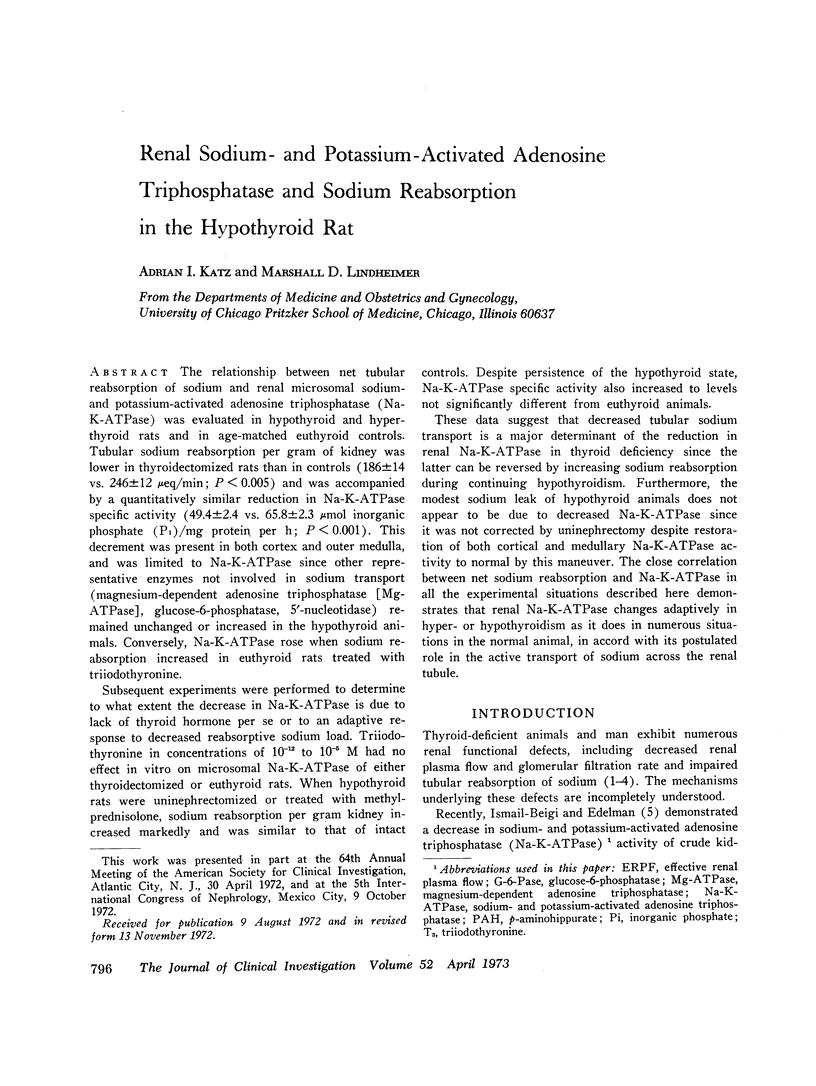
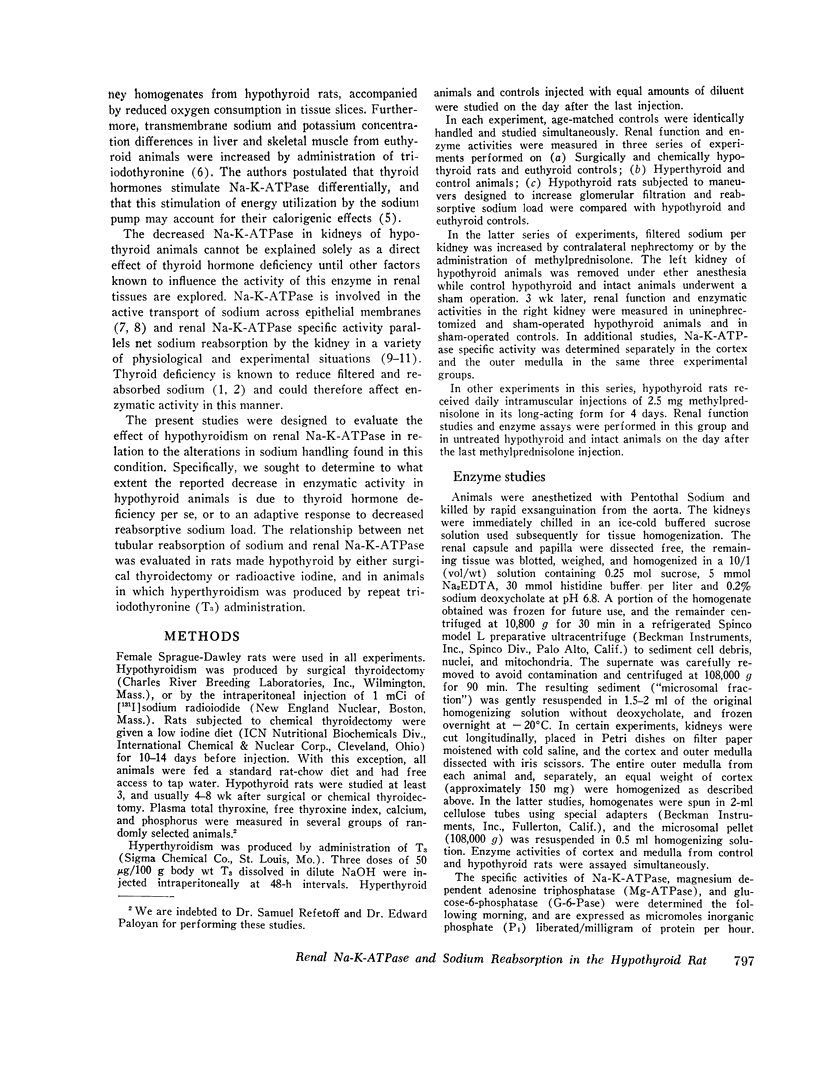
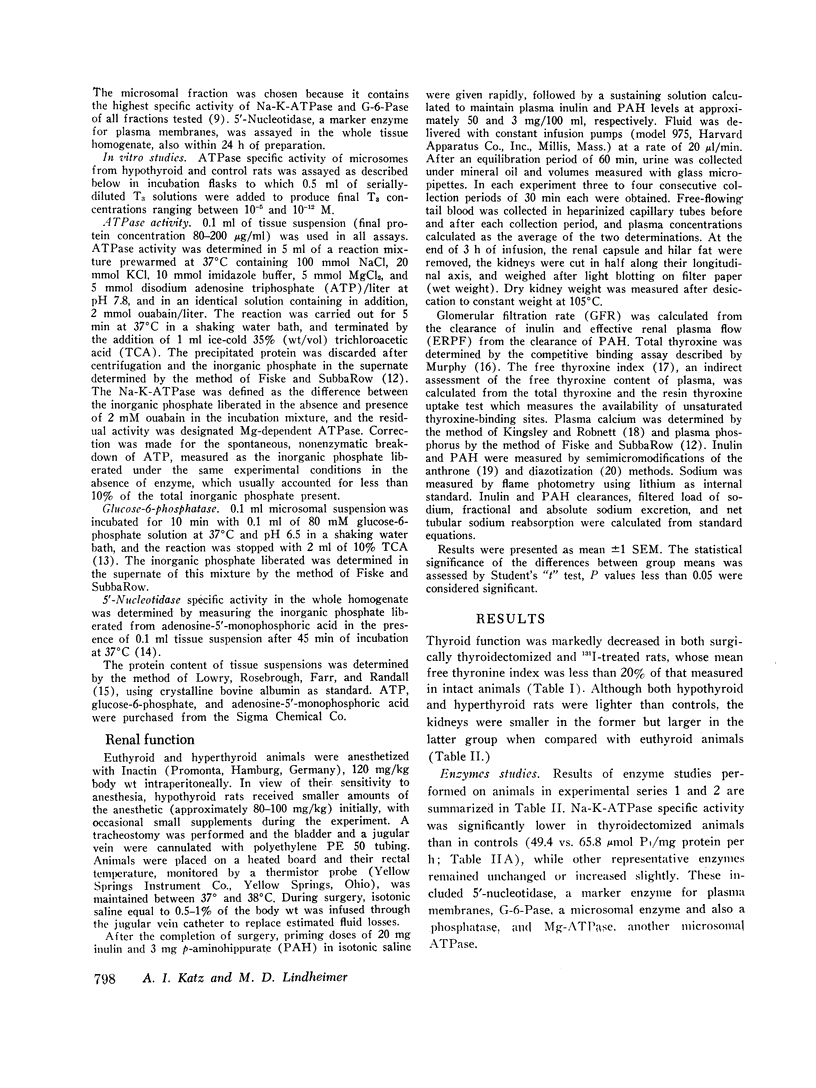
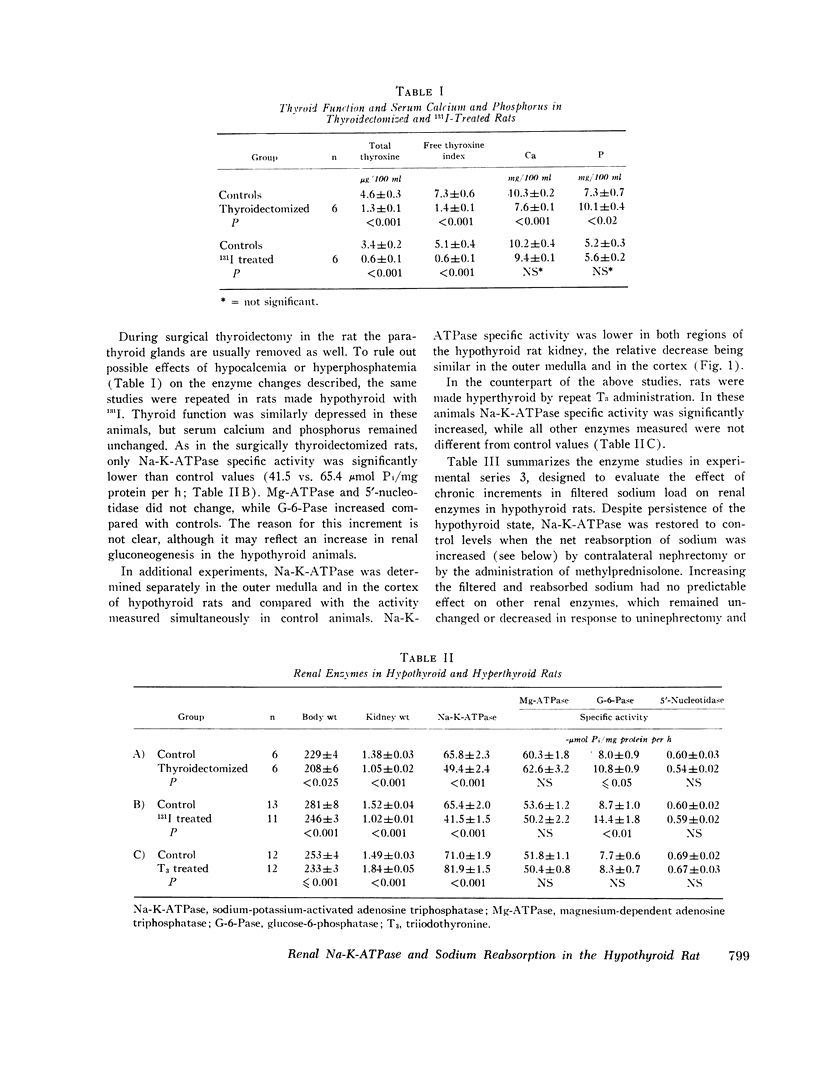
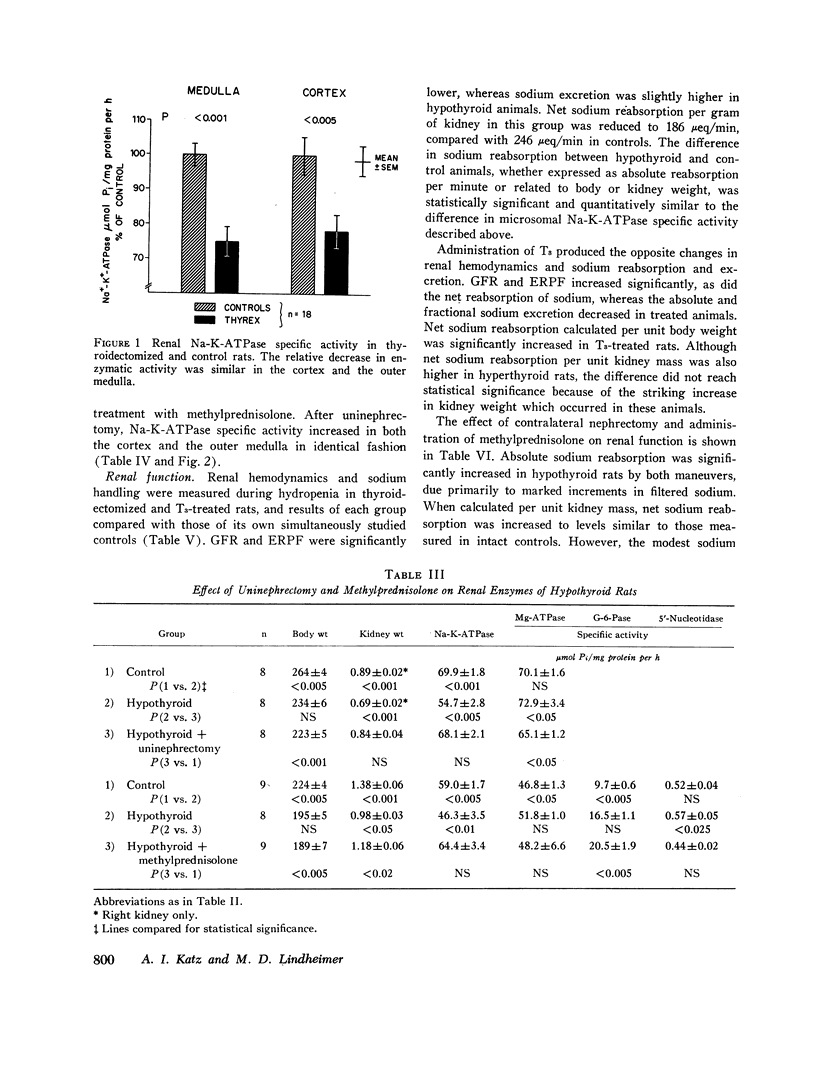
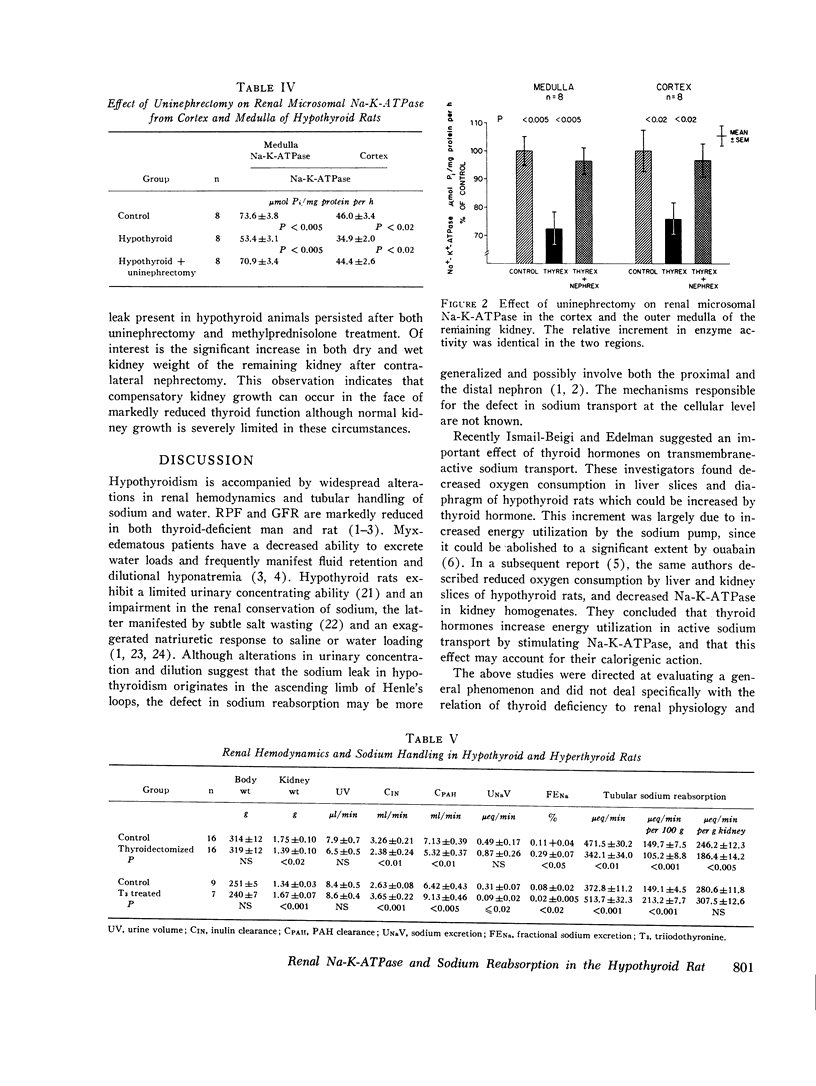
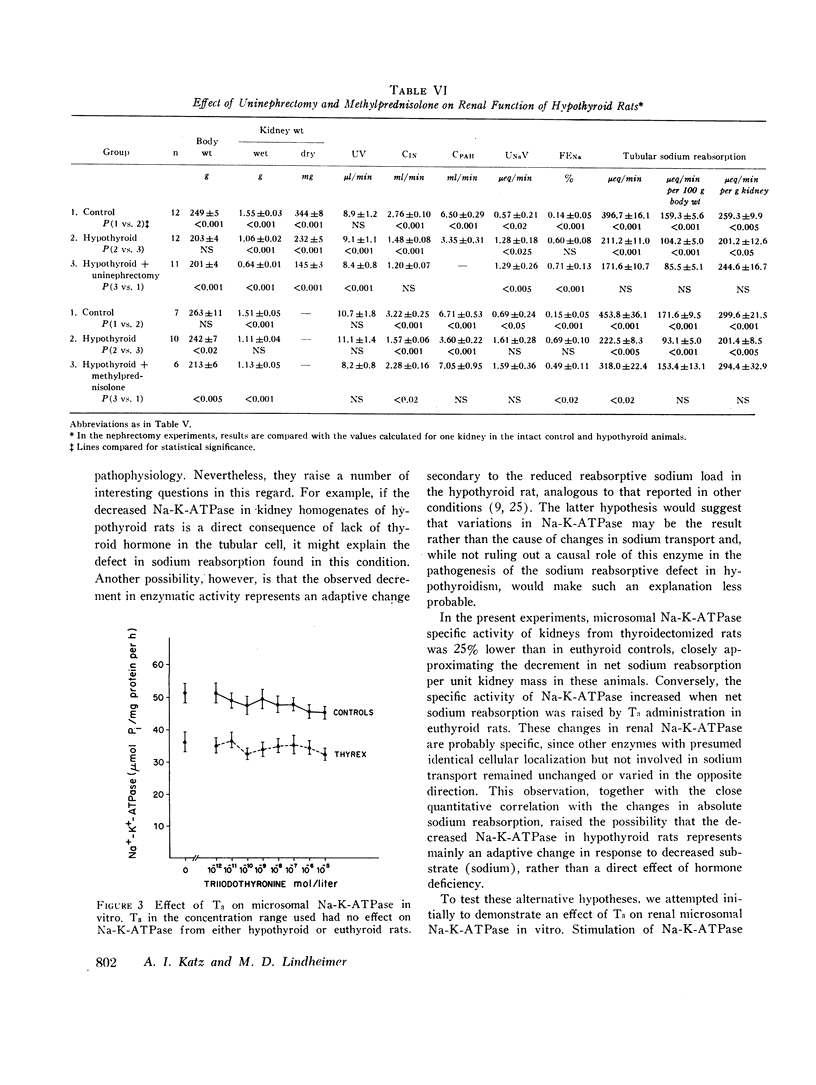
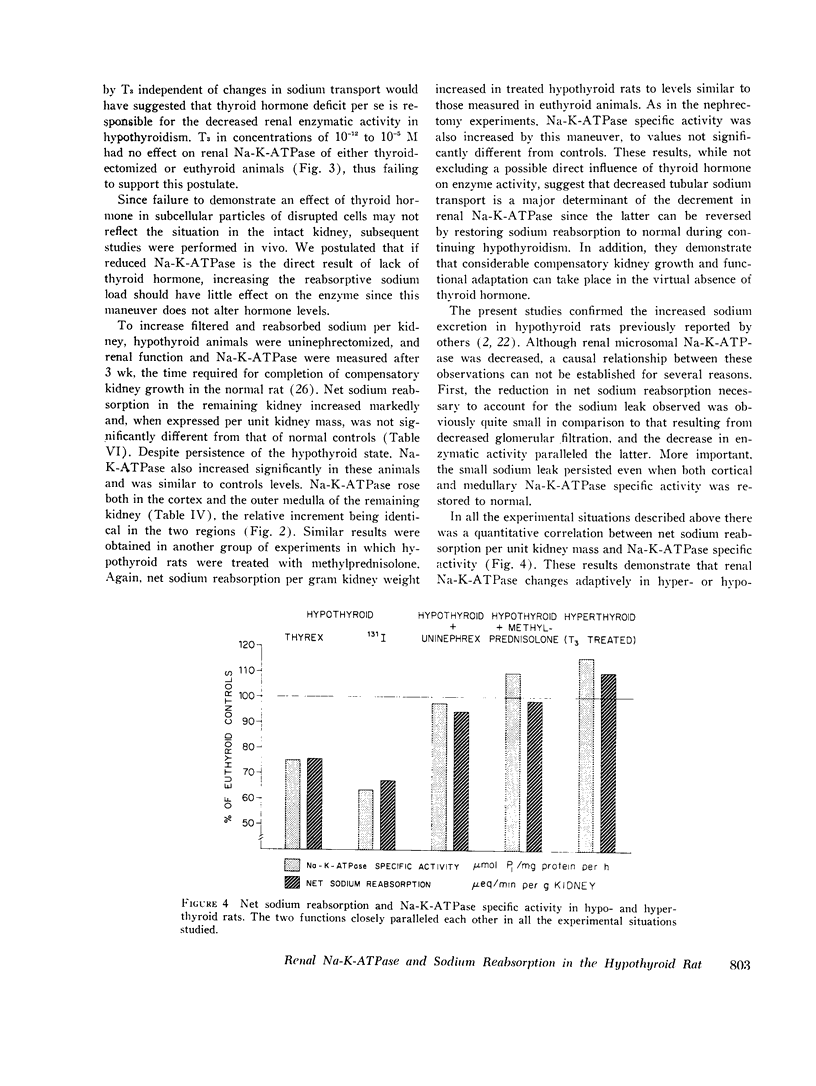
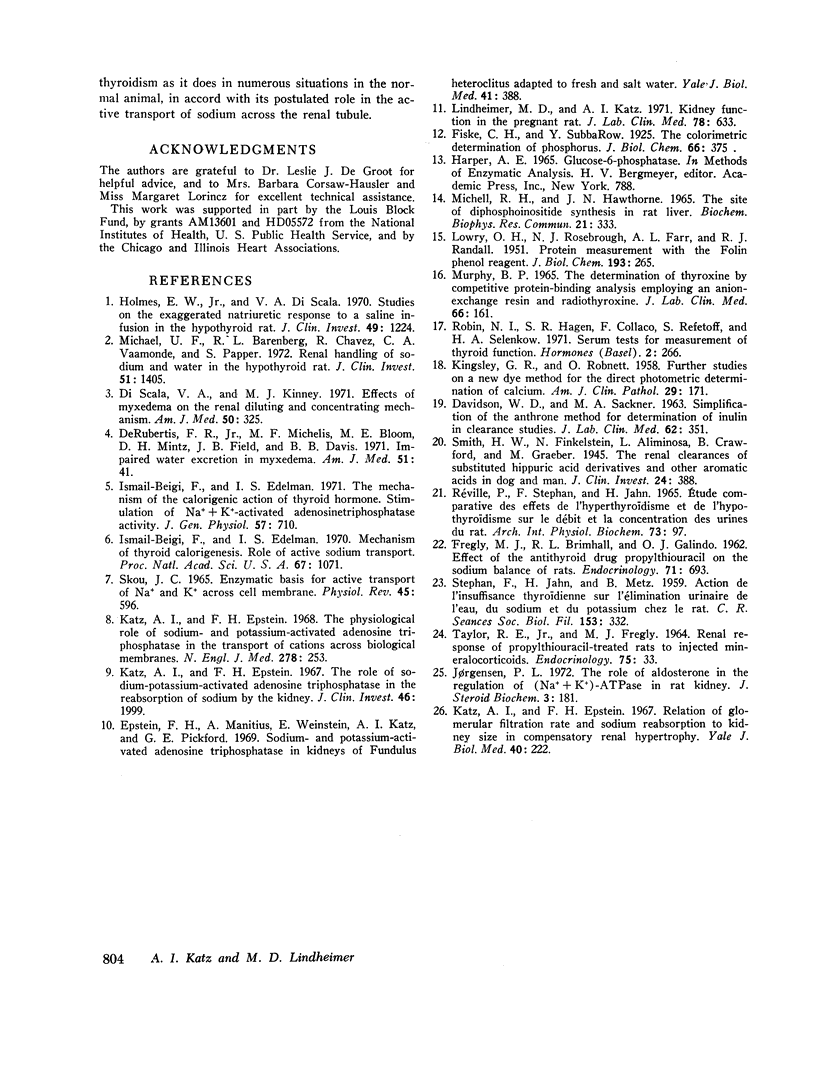
Images in this article
Selected References
These references are in PubMed. This may not be the complete list of references from this article.
- DAVIDSON W. D., SACKNER M. A. SIMPLIFICATION OF THE ANTHRONE METHOD FOR THE DETERMINATION OF INULIN IN CLEARANCE STUDIES. J Lab Clin Med. 1963 Aug;62:351–356. [PubMed] [Google Scholar]
- Derubertis F. R., Jr, Michelis M. F., Bloom M. E., Mintz D. H., Field J. B., Davis B. B. Impaired water excretion in myxedema. Am J Med. 1971 Jul;51(1):41–53. doi: 10.1016/0002-9343(71)90322-6. [DOI] [PubMed] [Google Scholar]
- Discala V. A., Kinney M. J. Effects of myxedema on the renal diluting and concentrating mechanism. Am J Med. 1971 Mar;50(3):325–335. doi: 10.1016/0002-9343(71)90221-x. [DOI] [PubMed] [Google Scholar]
- Epstein F. H., Manitius A., Weinstein E., Katz A. I., Pickford G. E. Sodium- and potassium-activated adenosine triphosphatase in kidneys of Fundulus heteroclitus adapted to fresh and salt water. Yale J Biol Med. 1969 Apr;41(5):388–393. [PMC free article] [PubMed] [Google Scholar]
- FREGLY M. J., BRIMHALL R. L., GALINDO O. J. Effect of the antithyroid drug propylthiouracil on the sodium balance of rats. Endocrinology. 1962 Nov;71:693–700. doi: 10.1210/endo-71-5-693. [DOI] [PubMed] [Google Scholar]
- Holmes E. W., Jr, DiScala V. A. Studies on the exaggerated natriuretic response to a saline infusion in the hypothyroid rat. J Clin Invest. 1970 Jun;49(6):1224–1236. doi: 10.1172/JCI106336. [DOI] [PMC free article] [PubMed] [Google Scholar]
- Ismail-Beigi F., Edelman I. S. The mechanism of the calorigenic action of thyroid hormone. Stimulation of Na plus + K plus-activated adenosinetriphosphatase activity. J Gen Physiol. 1971 Jun;57(6):710–722. doi: 10.1085/jgp.57.6.710. [DOI] [PMC free article] [PubMed] [Google Scholar]
- Izmail-Beigi F., Edelman I. S. Mechanism of thyroid calorigenesis: role of active sodium transport. Proc Natl Acad Sci U S A. 1970 Oct;67(2):1071–1078. doi: 10.1073/pnas.67.2.1071. [DOI] [PMC free article] [PubMed] [Google Scholar]
- Jorgensen P. L. The role of aldosterone in the regulation of (Na + + K + )-ATPase in rat kidney. J Steroid Biochem. 1972 Feb;3(2):181–191. doi: 10.1016/0022-4731(72)90049-0. [DOI] [PubMed] [Google Scholar]
- KINGSLEY G. R., ROBNETT O. Further studies on a new dye method for the direct photometric determination of calcium. Am J Clin Pathol. 1958 Feb;29(2):171–175. doi: 10.1093/ajcp/29.2_ts.171. [DOI] [PubMed] [Google Scholar]
- Katz A. I., Epstein F. H. Physiologic role of sodium-potassium-activated adenosine triphosphatase in the transport of cations across biologic membranes. N Engl J Med. 1968 Feb 1;278(5):253–261. doi: 10.1056/NEJM196802012780506. [DOI] [PubMed] [Google Scholar]
- Katz A. I., Epstein F. H. Relation of glomerular filtration rate and sodium reabsorption to kidney size in compensatory renal hypertrophy. Yale J Biol Med. 1967 Dec;40(3):222–230. [PMC free article] [PubMed] [Google Scholar]
- Katz A. I., Epstein F. H. The role of sodium-potassium-activated adenosine triphosphatase in the reabsorption of sodium by the kidney. J Clin Invest. 1967 Dec;46(12):1999–2011. doi: 10.1172/JCI105689. [DOI] [PMC free article] [PubMed] [Google Scholar]
- LOWRY O. H., ROSEBROUGH N. J., FARR A. L., RANDALL R. J. Protein measurement with the Folin phenol reagent. J Biol Chem. 1951 Nov;193(1):265–275. [PubMed] [Google Scholar]
- Lindheimer M. D., Katz A. I. Kidney function in the pregnant rat. J Lab Clin Med. 1971 Oct;78(4):633–641. [PubMed] [Google Scholar]
- Michael U. F., Barenberg R. L., Chavez R., Vaamonde C. A., Papper S. Renal handling of sodium and water in the hypothyroid rat. Clearance and micropuncture studies. J Clin Invest. 1972 Jun;51(6):1405–1412. doi: 10.1172/JCI106936. [DOI] [PMC free article] [PubMed] [Google Scholar]
- Michell R. H., Hawthorne J. N. The site of diphosphoinositide synthesis in rat liver. Biochem Biophys Res Commun. 1965 Nov 22;21(4):333–338. doi: 10.1016/0006-291x(65)90198-1. [DOI] [PubMed] [Google Scholar]
- Robin N. I., Hagen S. R., Collaço F., Refetoff S., Selenkow H. A. Serum tests for measurement of thyroid function. Hormones. 1971;2(5):266–279. doi: 10.1159/000178240. [DOI] [PubMed] [Google Scholar]
- SKOU J. C. ENZYMATIC BASIS FOR ACTIVE TRANSPORT OF NA+ AND K+ ACROSS CELL MEMBRANE. Physiol Rev. 1965 Jul;45:596–617. doi: 10.1152/physrev.1965.45.3.596. [DOI] [PubMed] [Google Scholar]
- STEPHAN F., JAHN H., METZ B. Action de l'insuffisance thyroïdienne sur l'élimination urinaire de l'eau, du sodium et du potassium chez le rat. C R Seances Soc Biol Fil. 1959;153(2):332–334. [PubMed] [Google Scholar]
- Smith H. W., Finkelstein N., Aliminosa L., Crawford B., Graber M. THE RENAL CLEARANCES OF SUBSTITUTED HIPPURIC ACID DERIVATIVES AND OTHER AROMATIC ACIDS IN DOG AND MAN. J Clin Invest. 1945 May;24(3):388–404. doi: 10.1172/JCI101618. [DOI] [PMC free article] [PubMed] [Google Scholar]
- TAYLOR R. E., Jr, FREGLY M. J. RENAL RESPONSE OF PROPYLTHIOURACIL-TREATED RATS TO INJECTED MINERALOCORTICOIDS. Endocrinology. 1964 Jul;75:33–41. doi: 10.1210/endo-75-1-33. [DOI] [PubMed] [Google Scholar]



